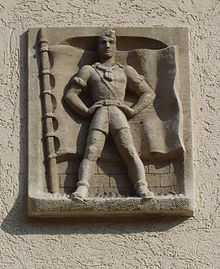Graz dam
| Graz dam | |
|---|---|
| Street in Berlin | |
| The Grazer Damm at the level of Peter-Vischer-Straße, looking north | |
| Basic data | |
| place | Berlin |
| District | Schöneberg |
| Created | March 27, 1939 |
| Connecting roads |
Autobahn junction Schöneberg , Munsterdamm |
| Cross streets |
Vorarlberger Damm , Peter-Vischer-Strasse, Brüggemannstrasse, Overbeckstrasse |
| Places | Grazer Platz |
| Buildings | Settlement on Grazer Damm, Nathanael Church , Auguste Viktoria Hospital |
| use | |
| User groups | Pedestrian traffic , bicycle traffic , car traffic , public transport |
| Technical specifications | |
| Street length | 1270 meters |
The Grazer Damm is a street in the south of Berlin 's Schöneberg district . The six-lane thoroughfare with a green central reservation leads over a length of 1.3 kilometers in a north-south direction from the Schöneberg motorway junction to the Insulaner on the border with the Steglitz district . The Grazer Damm was built at the end of the 1930s in connection with the construction of the now listed settlement on Grazer Damm . After Austria was " annexed " to the German Reich in 1938 , the Grazer Damm was named after Graz in 1939 , the capital of the then Gaus and today's Austrian state of Styria .
course
The Grazer Damm begins as a continuation of the Grazer Damm junction of the Schöneberg motorway junction, where the Berlin city ring (A 100) and the west bypass (A 103) intersect. Behind the intersection of Vorarlberger Damm it runs in a north-south direction through the settlement on Grazer Damm. After about 300 meters, the street crosses Grazer Platz , on the west side of which is the Nathanael Church , built in 1903 . On the Peter-Vischer-Straße behind it, the settlement on Grazer Damm only continues on the eastern side of the street, the western side is occupied by the site of the Auguste-Viktoria-Krankenhaus (AVK). Further south, on the east side, Brüggemannstrasse and Overbeckstrasse merge into Grazer Damm, until the road reaches the large intersection at Insulaner on the suburb of Steglitz. At this intersection with Prellerweg, which continues Thorwaldsenstrasse to the Priesterweg S-Bahn station , Grazer Damm ends and continues into Munsterdamm towards the south end .
Settlement on Grazer Damm

The settlement on Grazer Damm consists of six blocks, two to the west and four to the east of the eponymous street. It was built between 1938 and 1940 by the architects Ludwig Spreitzer, Hugo Virchow, Richard Pardon, Carl Cramer and Ernst Danneberg and is one of the few examples of housing architecture from the National Socialist era. The settlement is now a listed building. The approximately 2000 apartments - it is the largest completed settlement from the time of National Socialism in Berlin - were planned as “people's apartments” for workers and originally equipped with relatively simple furnishings. They were modernized in the 1980s. The history of the settlement can still be seen in the motifs of some relief panels above the house entrances. The perimeter block development was left open in less representative places: The planning principle behind it was called air raid protection city and was supposed to let the air pressure of high-explosive bombs escape and prevent a chimney effect in the event of a fire, with flames spreading through the whole house. The National Socialist planners already anticipated the bombing war in housing , although the National Socialists still tried to portray themselves officially as peace-loving. A lower building standard than was possible in the Weimar Republic was also used for these houses : a 1935 decree laid down the standards for “people's apartments”. The construction of "the cheapest rental apartments in single and multi-storey construction, which are extremely limited in terms of living space and equipment" was required. Builders only received funding if the construction costs were below 3500 marks per apartment. Originally, at most a third of the apartments had balconies.
Until June 2004 the apartments belonged to the state-owned housing association GSW . After GSW had been sold to a private investor, Vivacon AG acquired the estate in October 2004; in December 2004 Vivacon sold 886 of the 1529 apartments to the Austrian Conwert AG . The new owner wants to sell the apartments, giving priority to tenants buying their own apartment. However, very few tenants are financially able to do so: only 27% are gainfully employed, 18% are unemployed, 49% are retirees (as of 2006). The Vivacon began renovation work and the construction of balconies. This led to protests, because many financially disadvantaged tenants cannot cope with the associated rent increases of up to 20%. In this connection, the Berlin tenants' association accuses the owners of undertaking unnecessary modernization in order to be able to sell the apartments on at a higher price.
Web links
- Graz dam . In: Street name lexicon of the Luisenstädtischer Bildungsverein (near Kaupert )
- The bride is adorned In: tenant magazine of the Berlin tenants' association, June / July 2005
- Entry in the Berlin State Monument List
Individual evidence
- ^ Annette Tietenberg: The Grazer Damm housing estate on the Schöneberger Südgelände . In: Berlin in the past and present. Yearbook of the Berlin State Archives. Siedler, Berlin 1994, ISBN 3-88680-549-2 , pp. 207–230, here p. 207.
- ↑ Tempelhof-Schöneberg Monument List, page 9 ( Memento of the original from April 1, 2010 in the Internet Archive ) Info: The archive link was inserted automatically and has not yet been checked. Please check the original and archive link according to the instructions and then remove this notice.
- ^ A b Berlin tenants' association: Housing construction in the Nazi era. Unknown legacy.
- ↑ MieterEcho 318 / October 2006, online at: www.bmgev.de/mieterecho/318/09 , accessed on March 11, 2012
Coordinates: 52 ° 27 '54.1 " N , 13 ° 20' 52.6" E
